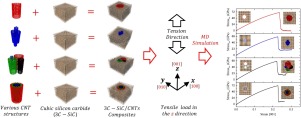Materials Today Communications ( IF 3.8 ) Pub Date : 2020-01-14 , DOI: 10.1016/j.mtcomm.2020.100922 Majid Kohestanian , Zihab Sohbatzadeh , Sasan Rezaee

|
The composites made from cubic silicon carbide (3C-SiC), as a matrix, and carbon nanotubes (CNTs), as reinforcements, have a wide range of applications in the industry because of their unique mechanical properties. However, to make effective and efficient composites of 3C-SiC/CNTs, the manner composition of 3C-SiC and CNTs and their volume fraction are among the biggest challenges. Therefore, in this study, to clarify the effects of different volume fractions of various CNT structures on 3C-SiC, continuous fiber composites of 3C-SiC/CNTs are investigated via the molecular dynamics (MD) method. The utilized reinforcements include Single Wall Carbon Nanotubes (SWCNT), Ropes Single Wall Carbon Nanotubes (RSWCNTs), and Multi-Walled Carbon Nanotubes (MWCNTs). The results reveal that the CNTs in the 3C-SiC/CNTs under axial stress are able to bear the most stress and yield before the 3C-SiC, the values of the Young's modulus of the 3C-SiC/SWCNTs, 3C-SiC/RSWCNTs, and 3C-SiC/MWCNTs boost as the chiral indices, the number of ropes, and the number of layers increase, respectively, and the 3C-SiC/CNTs, as continuous fiber composites, have the reinforced Young's modulus and the weakened fracture stress. In addition, among this type of composites, the 3C-SiC/MWCNTs with almost the same weight have the greatest value of the Young's Modulus; thus, they are the most appropriate composites for the industrial applications with high mechanical stiffness.
中文翻译:

立方碳化硅(3C-SiC)/不同类型的碳纳米管(SWCNT,RSWCNT和MWCNT)的连续纤维复合材料的机械性能:分子动力学模拟
由立方碳化硅(3C-SiC)作为基体和碳纳米管(CNT)作为增强体的复合材料由于其独特的机械性能而在工业上具有广泛的应用。然而,为了制造有效和高效的3C-SiC / CNT复合材料,3C-SiC和CNT的组成方式及其体积分数是最大的挑战。因此,在本研究中,为了阐明各种CNT结构的不同体积分数对3C-SiC的影响,通过分子动力学(MD)方法研究了3C-SiC / CNT的连续纤维复合材料。使用的增强材料包括单壁碳纳米管(SWCNT),绳索单壁碳纳米管(RSWCNT)和多壁碳纳米管(MWCNT)。结果表明,3C-SiC / CNTs中的CNTs在3C-SiC之前能够承受最大的应力和屈服,这是3C-SiC / SWCNTs,3C-SiC / RSWCNTs的杨氏模量值,3C-SiC / CNTs随手性指数,绳数和层数的增加而增强,作为连续纤维复合材料的3C-SiC / CNTs的杨氏模量增强且断裂应力减弱。此外,在这类复合材料中,几乎相同重量的3C-SiC / MWCNT具有杨氏模量的最大值;因此,它们是具有高机械刚度的工业应用最合适的复合材料。3C-SiC / CNTs和3C-SiC / CNTs随手性指数,绳数和层数的增加而增强,而3C-SiC / CNTs作为连续纤维复合材料具有增强的杨氏模量和减弱的断裂应力。此外,在这类复合材料中,几乎相同重量的3C-SiC / MWCNT具有杨氏模量的最大值;因此,它们是具有高机械刚度的工业应用最合适的复合材料。3C-SiC / CNTs和3C-SiC / CNTs随手性指数,绳数和层数的增加而增强,而3C-SiC / CNTs作为连续纤维复合材料具有增强的杨氏模量和减弱的断裂应力。此外,在这类复合材料中,几乎相同重量的3C-SiC / MWCNT具有杨氏模量的最大值;因此,它们是具有高机械刚度的工业应用最合适的复合材料。


























 京公网安备 11010802027423号
京公网安备 11010802027423号